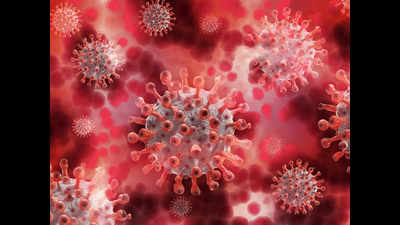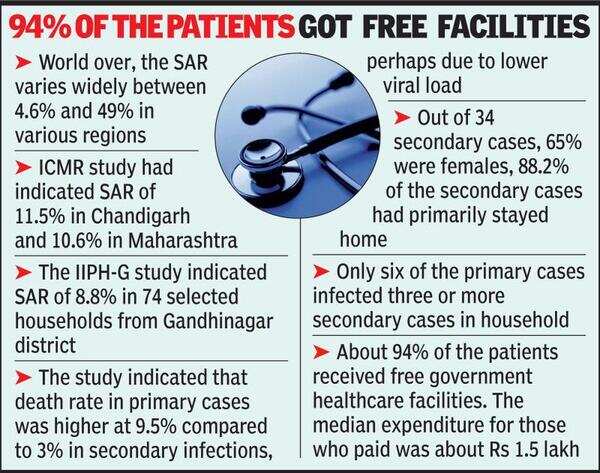- News
- City News
- ahmedabad News
- Covid-19: Secondary attack rate of 8.8% for Gandhinagar
Trending
This story is from September 6, 2020
Covid-19: Secondary attack rate of 8.8% for Gandhinagar
A study carried out by the researchers from the Indian Institute of Public Health, Gandhinagar (IIPH-G), claimed the secondary attack rate (SAR) of 8.8% in confirmed Covid-19 positive patients in Gandhinagar district. SAR can be explained as the new (secondary) cases out of the total contacts of the primary infected person, said experts.

Representative image
AHMEDABAD: A study carried out by the researchers from the Indian Institute of Public Health, Gandhinagar (IIPH-G), claimed the secondary attack rate (SAR) of 8.8% in confirmed Covid-19 positive patients in Gandhinagar district. SAR can be explained as the new (secondary) cases out of the total contacts of the primary infected person, said experts.
The results also pointed at more secondary infection among the women and less mortality among the secondary cases.

The primary study, titled ‘Household Secondary Attack Rate in Gandhinagar district of Gujarat state from Western India’ by a team of authors led by Komal Shah, assistant professor at IIPH-Gandhinagar (IIPH-G) and Dileep Mavalankar, director of IIPH-G, is currently under review.
“From these households, we selected 386 of their close contacts. Their analysis revealed 34 positive cases, giving 8.8% of SAR,” she said.
Talking about relevance of the study, Mavalankar said that it’s one of the first primary-level research in SAR for the state.
“We had earlier conducted systematic review of the global papers on SAR and also studied the result of a similar work by Indian Council of Medical Research (ICMR) for India. The primary finding of 8.8% SAR is almost on the lines of ICMR study that showed SAR of 6% for India,” he said.
He added that there could be factors ranging from genetics to immunity which could be reason for the phenomenon.
“If we see SAR of a few other infectious diseases, it’s higher than Covid-19,” he said.
“But it should be kept in mind that the study was limited to rural or semi-urban area with relatively less denser population and it was based on RT-PCR confirmed cases. It’s possible that SAR could be higher in cities like Ahmedabad and it’s also possible that some of the infections could have gone unreported.”
The results also pointed at more secondary infection among the women and less mortality among the secondary cases.

The primary study, titled ‘Household Secondary Attack Rate in Gandhinagar district of Gujarat state from Western India’ by a team of authors led by Komal Shah, assistant professor at IIPH-Gandhinagar (IIPH-G) and Dileep Mavalankar, director of IIPH-G, is currently under review.
Shah said that for the study 74 household in Gandhinagar district except municipal corporation area were randomly selected that reported at least one RT-PCR confirmed case between March 28 and July 2.
“From these households, we selected 386 of their close contacts. Their analysis revealed 34 positive cases, giving 8.8% of SAR,” she said.
Talking about relevance of the study, Mavalankar said that it’s one of the first primary-level research in SAR for the state.
“We had earlier conducted systematic review of the global papers on SAR and also studied the result of a similar work by Indian Council of Medical Research (ICMR) for India. The primary finding of 8.8% SAR is almost on the lines of ICMR study that showed SAR of 6% for India,” he said.
He added that there could be factors ranging from genetics to immunity which could be reason for the phenomenon.
“If we see SAR of a few other infectious diseases, it’s higher than Covid-19,” he said.
“But it should be kept in mind that the study was limited to rural or semi-urban area with relatively less denser population and it was based on RT-PCR confirmed cases. It’s possible that SAR could be higher in cities like Ahmedabad and it’s also possible that some of the infections could have gone unreported.”
End of Article
FOLLOW US ON SOCIAL MEDIA










